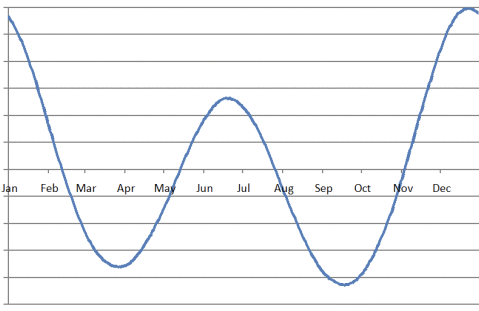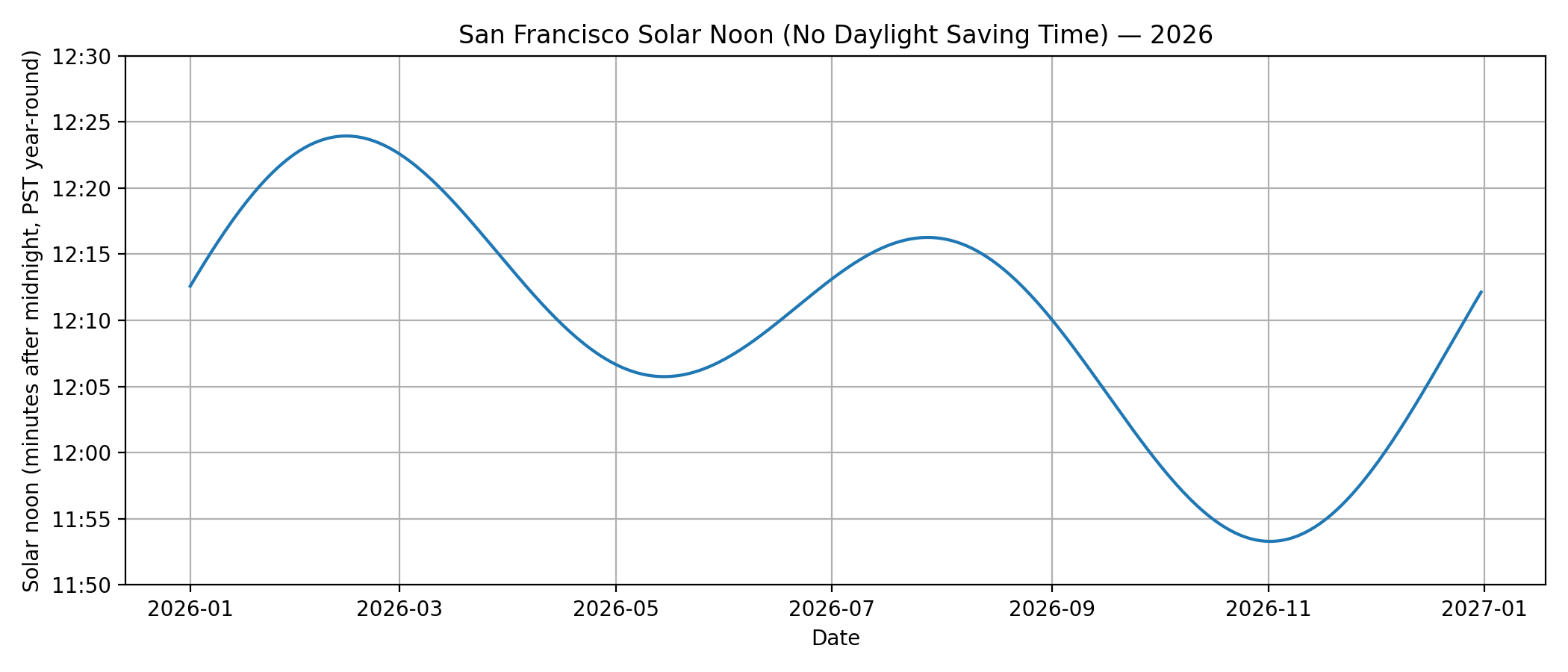What is the longest day of the year?
Most people think of June 21st as the longest day of the year. If you define a "day" to be the period of daylight during a 24-hour period, then they would be right. However, if we measure a day from noon one day to noon the next, the longest "solar" day of the year falls on December 22nd or 23rd.
Recall, that the earth revolves around the sun 360 degrees every 365 days. That's just under one degree per day. In addition, the earth rotates on its axis 360 degrees each day (approximately 24-hour). Therefore, from high noon on one day to high noon on the next, the earth must rotate almost 361 degrees to account for the earths revolution around the sun. And that is what the earth does, and that is how we define a 24-hour period.
However, the earth does not revolve around the sun in a perfect circle. Rather, it is an ellipse, and the sun is not at the center of the ellipse. Therefore, when the earth is closest to the sun (the perihelion of the ellipse), it moves faster around the sun than at any other time. And this means that the earth must spin further on its axis from high noon of one day to high noon of the next - more rotation takes more time. Therefore, the solar day is longer when the earth is closer to the sun - up to 8 seconds longer than the average day. Conversely, when the sun is the at the long part of the ellipse (the co-vertex) the earth is moving its slowest and the solar days are shorter.
But wait — Earth’s tilt has an even bigger effect on the length of a solar day. Although Earth rotates at a nearly constant rate, we measure time by how far the Sun moves east-to-west across the sky. Because Earth’s axis is tilted, the Sun does not move straight along the same east-west path all year. Instead, it follows a tilted path through the sky. When Earth is near its maximum axial tilt of about 23.5°, equal amounts of the Sun’s motion along this tilted path do not translate into equal east-west motion. As a result, the Sun sometimes advances eastward more slowly than average, so Earth must rotate slightly longer before the Sun returns to its highest point in the sky. At its maximum, this adds about 21 seconds to the length of the apparent solar day compared to the average day.
It turns out that the earth is closest to the sun on January 4 of each year. And we all know that the winter solstice is sometime between December 20th and 23rd. These two factors work together to make December 22 or 23 the longest solar day of the year at about 24 hours and 30 seconds.
So, what is the shortest solar day of the year?
September 17th or 18th.
What is the Equation of Time?
Here is a graph of a typical year vs. the length of the solar day. Note how the days are longer at the perihelion (around January 4th) and aphelion (around July 4th) of the ellipse and shorter near the co-vertexes (around April 5 and October 6).

The "Equation of Time" is the difference between time as read from a sundial and a clock. A sundial shows "apparent solar time," which is based on the actual position of the Sun in the sky. A clock shows "mean solar time," which assumes that all days are exactly 24 hours long. The Equation of Time varies over the course of a year due to the elliptical shape of Earth’s orbit and the tilt of its axis. At certain times of the year, sundials can be up to about 16 minutes fast or slow compared to clocks.
When is high noon in San Francisco?
High noon in San Francisco occurs at about 12:10 PM during Standard Time (early November to mid-March) and about 1:10 PM during Daylight Saving Time (mid-March to early November). However, it varies evey day. Here's a graph of the actual time, but neglecting daylight savings time. Therefore, one needs to add an hour to the time during daylight saving time.

Why is the earliest sunset before the winter solstice?
The earliest sunset occurs before the winter solstice because, in early December, shrinking daylight and an earlier-drifting solar noon both push sunset earlier on the clock. As the winter solstice approaches, each day has less total daylight than the one before it. Shorter days mean that sunrise happens later and sunset happens earlier. If this were the only effect at work, the earliest sunset would occur on the solstice itself, when the day is shortest.
However, the time of solar noon—when the Sun reaches its highest point in the sky—does not occur at the same clock time every day. In early December, solar noon shifts slightly earlier each day due to Earth’s axial tilt and its uneven speed along its orbit. Sunrise and sunset are positioned roughly symmetrically around solar noon, so when solar noon moves earlier, both sunrise and sunset move earlier as well.
In early December, these two effects act in the same direction for sunset. The shortening day pushes sunset earlier, and the earlier-shifting solar noon pushes it earlier still. Because both effects reinforce each other, sunset reaches its earliest clock time several days before the solstice, typically around December 7–8 at mid-latitudes.
This is why the earliest sunset happens before the winter solstice, even though the solstice marks the shortest day of the year.
The latest sunrise occurs after the winter solstice for similar reasons. Although the winter solstice marks the shortest day of the year, it does not mark the latest sunrise. Immediately after the solstice, day length does begin to increase, which by itself would make sunrise earlier. However, solar noon continues to drift later on the clock for several days after the solstice. Because sunrise occurs a fixed amount of time before solar noon, this later-moving solar noon initially outweighs the growing day length and pulls sunrise later. Only after solar noon stops drifting later does the increasing daylight dominate, allowing sunrise to finally begin moving earlier.
And the size and timing of these effects depend on latitude. Near the equator, day length changes very little over the year, so the shifts in sunrise and sunset around the solstice are small and closely clustered in time. At higher latitudes, day length changes much more rapidly near the solstices, which spreads out the dates of the earliest sunset, the shortest day, and the latest sunrise and makes the clock-time shifts more noticeable. The sequence remains the same everywhere outside the polar regions, but the spacing between these events grows with latitude. Summarizing, latitude affects the size of the clock-time shifts, but the calendar spacing of the earliest sunset and latest sunrise is set by a balance between changing day length and solar-noon drift, and does not increase steadily with latitude.
For more info see: Sunrise sunset calendar (e.g., San Francisco) How the length of a day changes over the year Why December Has The Longest Days The earliest sunset comes before the winter solstice